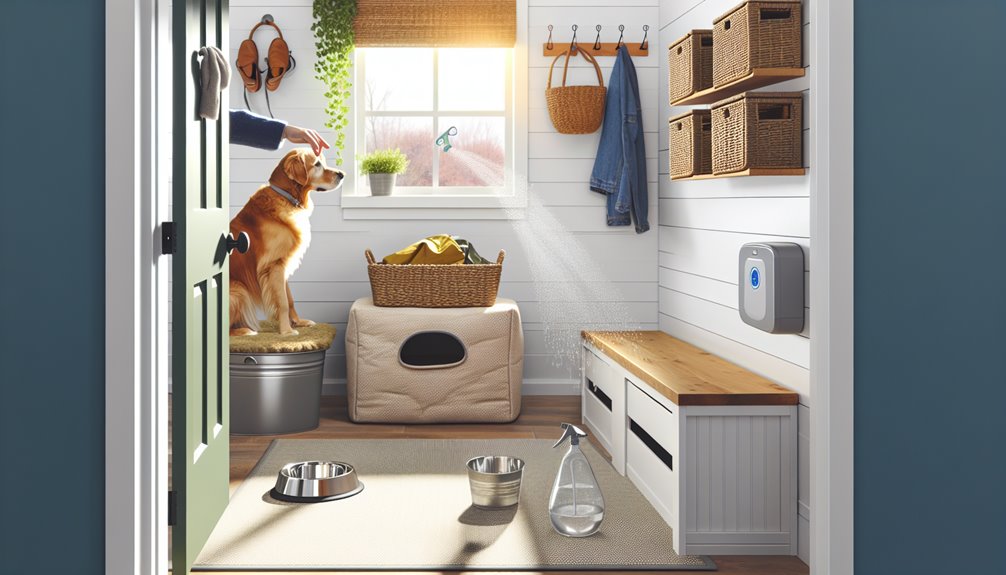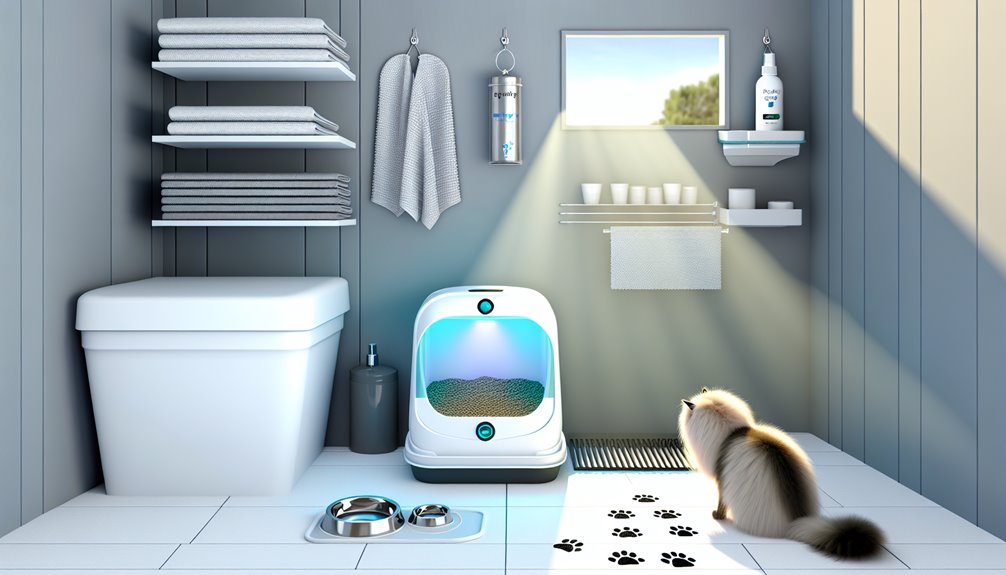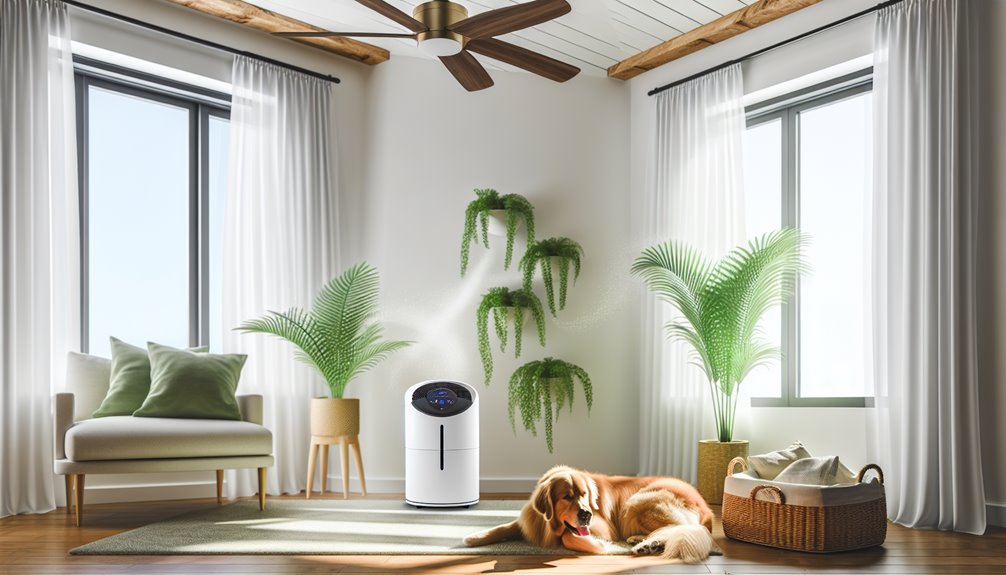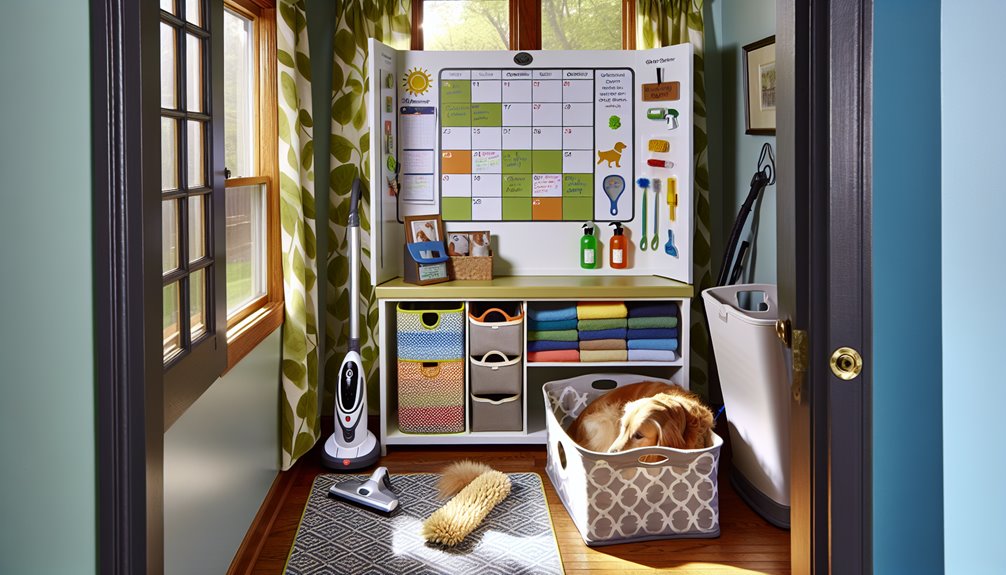Most pet odors don’t start on carpets—they start in the air and on paws before they ever settle. You can stop buildup by airing rooms daily, running a HEPA purifier with carbon near pet zones, and spot-treating accidents immediately with enzyme cleaner—blot, don’t scrub. Wipe paws after walks, brush and bathe on a schedule, and launder bedding weekly with an extra rinse and a splash of white vinegar. Want a routine that actually sticks?
Daily Deodorizing Habits That Actually Work

Nearly every home with pets can stay fresh with a few consistent, low-effort habits. You’ll set the tone each morning: open windows for ten minutes, then run a HEPA-equipped purifier near pet zones. Spot-treat accidents immediately with an enzyme cleaner; blot, don’t scrub. Wipe paws after walks to keep outside odors off rugs. Use coat sprays designed for pets—light mist, then brush—to neutralize smells without masking. Practice scent rotation: alternate two or three mild, pet-safe deodorizers weekly so your nose doesn’t acclimate. Launder pet bedding twice weekly; add a cup of white vinegar to the rinse. Empty litter and waste daily.
Grooming Routines That Cut Odor at the Source
Those daily deodorizing habits keep the air fresh, but real odor control starts on the coat, skin, and mouth.
Commit to regular brushing to lift dander, spread natural oils, and remove odor-trapping undercoat. Bathe with a mild, species-appropriate shampoo; rinse thoroughly and dry completely to prevent musty smells. Prioritize ear cleaning with vet-approved solution—odor often signals yeast or debris. Trim nails and clean paw fur that wicks grime indoors. Wipe facial folds and tails on breeds prone to moisture. Brush teeth daily; pair with enzymatic gel if needed. Schedule skin checks for hotspots or parasites. Document routines, observe changes, and adjust to keep pets—and homes—fresh.
Smart Litter Box and Pet Area Management

Dial in your pet’s zones to stop smells before they spread. Map feeding, litter, and rest areas with clear boundaries, keeping high-traffic spots easy to sanitize. Choose a litter box with automatic scooping to reduce exposure time; pair it with odor sealing liners and a covered waste bin. Place mats to capture granules, and wipe hard surfaces daily with pet-safe enzymatic cleaner. Ventilate with a small fan or HEPA purifier near, not at, the box. For dogs, designate a potty patch with washable turf and a drip tray. Log cleaning tasks on a shared schedule so everyone supports consistent care.
Textiles, Bedding, and Soft Surfaces: Wash Schedules and Methods
Regularly tackle textiles to keep odor reservoirs from taking hold. Set clear schedules: launder pet bedding weekly on hot, your own bedding biweekly, throws and washable covers every 7–10 days. Pre-treat spots with enzyme spray; use an extra rinse to purge dander. Rotate pillow protectors and mattress encasements monthly. Between washes, lightly mist fabric refreshers formulated for pets.
- A drum of warm water swirling suds through a well-loved dog blanket.
- Sunlit sheets billowing on a line, odors lifted by fresh air.
- Zippered pillow protectors stacked, ready for a clean swap.
- A handheld steamer gliding over curtains, releasing faint, stubborn scents.
Flooring and Carpets: Quick Cleanups and Deep-Refresh Tactics

With fabrics under control, turn attention to the ground where odors settle fast. Vacuum high-traffic lanes daily, using slow overlapping passes and an edge tool along baseboards. For accidents, act immediately: blot, don’t rub; apply targeted spot cleaning techniques, then rinse lightly and blot again. Lift hair and dander from grout lines with a stiff nylon brush before mopping. On sealed hard floors, use a microfiber mop and hot-water rinse after sweeping. For carpets, perform a monthly deep-refresh: pre-vacuum, pre-treat, then extract with a rental or portable unit. Apply textured rugcare tips—shake outdoors, beat, then vacuum from multiple directions.
Odor-Neutralizing Products Pros Recommend
Although good habits set the foundation, pros lean on a tight roster of odor-neutralizers that target molecules—not just mask smells. You want products that break down odor at the source and protect the spaces your people and pets share. Choose formulas that are safe, fast-acting, and surface-appropriate.
- Enzymatic sprays: saturate urine spots; let enzymes digest odor-causing proteins before blotting.
- Oxidizing cleaners: apply lightly on stubborn organic stains; rinse to prevent residue.
- Activated charcoal: place discreet sachets in litter areas, carriers, and shoe closets to trap lingering VOCs.
- Encapsulating deodorizers: mist textiles; polymers bind odor molecules until your next wash.
Ventilation, Air Purifiers, and Humidity Control

Those surface solutions work best when the air cooperates. Prioritize steady air exchange: crack opposite windows for cross-breeze or use a balanced ventilation fan to refresh rooms pets frequent. Run a HEPA air purifier with activated carbon near resting areas; size it to the room and let it cycle continuously on low. Keep relative humidity between 40–50% to discourage odor-causing microbes. Use a dehumidifier with moisture sensors and auto mode; empty and sanitize the tank weekly. In damp seasons, run bathroom and laundry exhausts longer. Replace HVAC filters monthly, and aim vents away from litter zones to reduce recirculating dander.
Stain and Accident Protocols for Fast, Effective Response
Act fast to stop odors from setting in and stains from spreading. Your response window is minutes, not hours. Prioritize immediate blotting with white cloths—press, don’t rub—to lift moisture without pushing it deeper. Then apply enzymatic cleaners to break down urine proteins and neutralize odor at the source. Work methodically, protecting fibers and finishes while caring for the animal’s dignity.
1) Picture towels stacked, hands pressing firmly, moisture disappearing.
2) See a test spot, then a measured spray of enzymatic cleaners, soaking the area.
3) Imagine gentle tamping with a soft brush, then patient dwell time.
4) Visualize cool-water rinse, final blot, and airflow restoring freshness.
Setting a Weekly Maintenance Plan You’ll Stick To

Consistently scheduling small, specific tasks each week keeps odors from ever gaining ground and makes upkeep effortless. Build a routine checklist: launder pet bedding, vacuum high-traffic lanes, mop hard floors with enzymatic cleaner, wash food and water bowls, wipe litter or crate areas, and refresh air filters. Assign weekdays to tasks so nothing piles up. Set phone reminders and keep supplies staged where you use them. Track completion on a visible chart. Tie your routine checklist to a simple reward system—tea break, short walk, or playlist—so you’ll reinforce consistency. If you share responsibilities, delegate clearly and review outcomes together weekly.
Conclusion
At Hydra Clean, we understand how much you love your furry friends, and we want to help you keep your home smelling fresh and inviting! By following these simple tips, you can stay ahead of pet odors and maintain a clean, comfortable environment. If you ever need a little extra help, don’t hesitate to reach out to us. We’re here to support you with professional cleaning services that will leave your home sparkling. Visit myhydraclean.com or give us a call at (601) 336-2411 to learn more. We can’t wait to help you create a space that feels like home!

